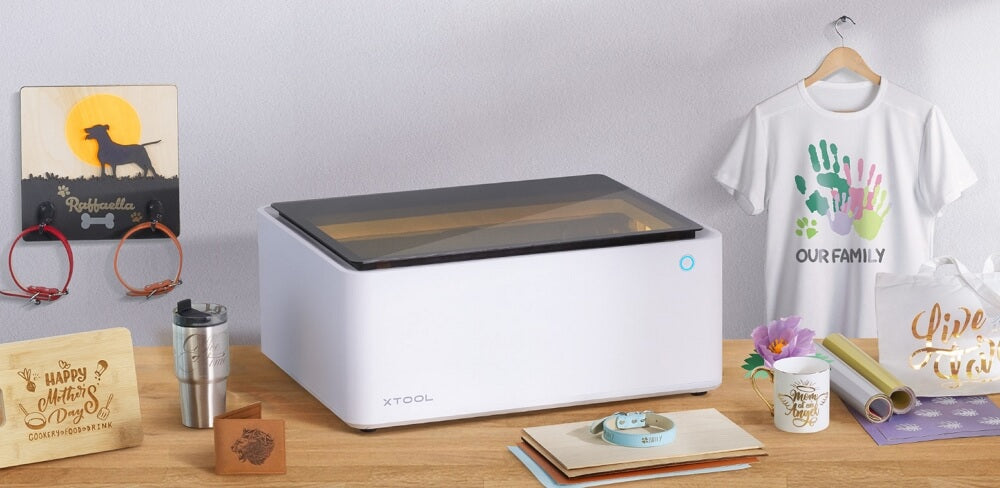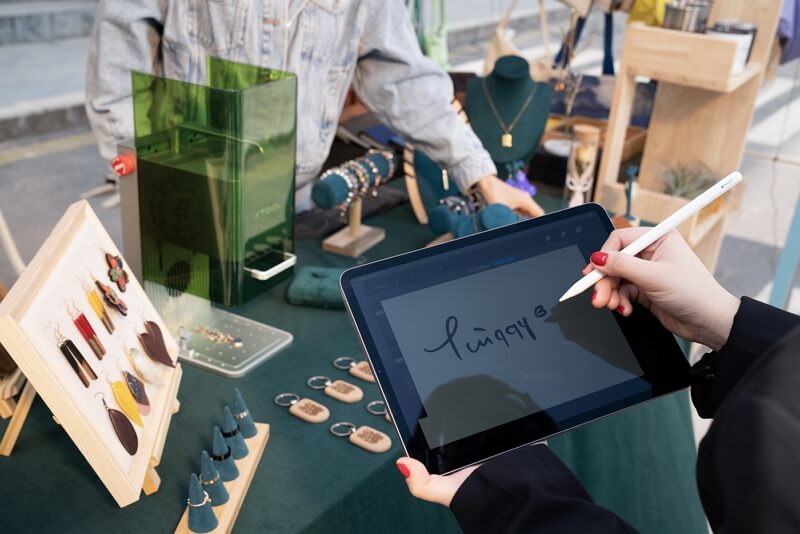Best Diode Laser Engravers In 2024
Lasers are commonly classified based on their active gain medium—the source that excites electrons to form a laser. A prevalent type, that utilizes a semiconductor diode as a gain medium, is known as a diode laser machine.
Diode laser engravers are compact, affordable, and primarily designed for small use cases. If you're a hobbyist, DIYer, or small business aiming to get into the crafting market, a diode laser engraver is something you need.
This article highlights the top diode laser engravers available in the market and crucial factors you need to consider before making a purchase.
In This Article
- Top Diode Laser Engraver Picks for 2024
- Factors to Consider When Choosing a Diode Laser Engraver
- What Can Diode Lasers Engrave and Cut?
- FAQs On Diode Laser Engravers
- Conclusion
Top Diode Laser Engraver Picks for 2024
Before we get into the details of each machine, here’s a quick introduction to all three picks on our list:
| Specification | xTool S1
(Best Overall) | xTool M1
(Best for Beginners) | xTool F1
(Best for Small Businesses) |
|---|---|---|---|
| Price | $2,299 | $1,099 | $1,599 |
| Optical Power | 40W, 20W, 10W | 10W | 10W |
| Max. Engraving Speed | 600 mm/s | 250 mm/s | 4000 mm/s |
| Working Area | 498*319mm | 385 * 300mm | 115*115mm |
| Positioning Mode | Pin-Point Positioning System | 16MP Camera Positioning | Auto Focus |
| Passthrough Slot | ✔ | ❌ | ❌ |
| Curved Surface Engraving | ✔ | ❌ | ❌ |
| Rotary Engraving | ✔ | ✔ | ✔ |
| Batch Engraving | ✔ | ✔ | ❌ |
| Software | XCS, Lightburn | XCS, Lightburn | XCS, Lightburn |
Best Overall Diode Laser Engraver: xTool S1
The xTool S1 is the latest addition to the xTool laser engraving lineup. It is offered in three variants: 40W, 20W, and 10W, each targeting a distinct segment of users.

S1’s flagship variant (40W) is the most powerful enclosed laser module currently available in diode engravers. Additionally, a 2W infrared (IR) switchable diode module is available, ideal for engraving metals and plastics. The S1 provides xTool’s benchmark 600mm/s engraving speed, surpassing that of its competitors.
Featuring a generous bed size of 23.93*15.16 inches, the xTool S1 outpaces most competitors, which average around 15*13 inches. This ample space can be expanded further with an auto-passthrough slot that allows you to work on lengths up to 118 inches.
A significant feature of the S1 is its capability to engrave on curved and cylindrical surfaces—be it a bowl, a hydro flask tumbler, or any irregularly shaped object.
Innovatively, the S1 eschews cameras in favor of a more advanced, precise pinpoint positioning system. Users can mark various points along the edges of the object to get an outline of the material in the laser engraver software, where the design can be mapped.
The S1 is designed with safety as a priority. It is a class 1 laser product with an array of built-in safety features. It is fully enclosed with a laser filtering lid to ensure no gases or laser emissions escape. Moreover, it includes a lid-open safety stop button and 5-directional safety sensors to prevent mishaps.
Notable Specs:
- World’s first 40W enclosed diode engraver
- Supports Curved surface engraving
- Engraves at 600 mm/s
- 4-Tier Safety: laser filtering lid, lid open safety stop, enclosed body, and flame detection sensors
- Class 1 Laser Product
Best Diode Laser Engraver for Beginners: xTool M1
xTool M1 is a beginner-friendly laser engraver, designed for beginners or hobbyists getting into the crafting segment. M1 is not just a diode laser engraver but also the world’s first hybrid laser and vinyl cutter.

It packs a 10W diode laser for cutting and engraving common materials and a separate blade cutter for cutting vinyl. M1 engraves at 250mm/s. The results are best with an ultra-fine laser spot size of 0.08mm by 0.08mm.
On the inside, M1 features a 16MP camera, which provides a preview of the workspace, and lets you drag and drop designs onto the material. This camera setup further enhances its utility with a batch engraving feature that allows for engraving on multiple objects at once.
With a working area of 385*300 mm, the M1 is well-suited for small projects, and its capacity can be extended vertically with a riser base. It also supports rotary engraving through xTool’s rotary attachment, RA 2 Pro.
M1 is designed for carefree use at home. It has a Class 1 rating, certified by FDA. The machine is fully-enclosed and the top blue-light filtering lid protects users from laser exposure.
To maximize the M1’s capabilities, various add-ons are available, including a riser base for vertical expansion, an air assist for enhanced results, and an xTool Smoke Purifier for exhaust evacuation in an enclosed space.
Notable Specs:
- World’s first hybrid laser and blade cutter
- 16MP for workspace preview
Best Diode Laser Engraver for Small Business: xTool F1
For small businesses needing on-the-spot engraving, such as at craft fairs or in shops, the portable xTool F1 is an ideal choice.

F1’s standout feature is its portability. It weighs just 4.6 kg and comes in a hand-held design that makes engraving jobs more simplified. F1 is also the fastest diode laser engraver on the market. Its engraving speed of 4000 mm/s is unmatched – a performance level typically seen only in industrial fiber laser machines.
F1 is one of the first laser engravers to feature dual laser technology. With a click of a button, you can switch between infrared (2W) and diode laser (10W). Diode laser makes it capable of common materials including wood, acrylic, leather, paper, rock, and glass. The IR expands that to metals and plastics.
This portable laser engraver features Galvo laser engraving technology, which not only makes it the fastest laser engraver but also helps achieve a motion accuracy of 0.00199 mm. Its blue light preview feature is another standout feature that enables users to preview engraving outcomes before commencement.
Designed for safety in home and indoor settings, the F1 is equipped with an external translucent cover to filter the laser, and an in-built air purifier to efficiently manage smoke.
Enhancements are available, including a slide extension kit to increase the workspace area to 400*115mm, and a rotary attachment for cylindrical objects, offering further versatility and utility.
Notable Specs:
- World’s first true dual laser engraver
- Handheld design
- Industrial grade engraving speed of 4000mm/s
- Blue light engraving preview
Factors to Consider When Choosing a Diode Laser Engraver
Buying a new laser engraver machine can be hard, especially if you’re new and unaware of technicalities. These are some of the specifications that must be valued when buying a diode laser engraver:
Power and Speed
Optical power defines the machine’s capability of penetrating and cutting thicker materials. For basic surface engraving, a nominal power range of 5 to 10W is sufficient. But for deep surface engraving or cutting, a higher optical power is needed.
Engraving speed is equally important, as higher speeds reduce job completion time, boosting productivity.
Accuracy and Precision
Engraving quality depends on the laser's spot size and the machine's motion accuracy. A finer laser spot size yields clearer results and allows for intricate detail levels in designs.
Bed Size
The size of a diode laser engraver's internal working area, or bed size, determines the maximum project size. Ensure the machine's bed size fits the scope of your intended projects. Some models offer extended workspaces with passthrough slots or riser bases. Prioritize those systems.
Safety System
Safety features are crucial for any engraver. Look for an engraver that is fully enclosed and has a fire-alert system. Purchase a machine that doesn’t require a separate accessory for working.
Connectivity
This refers to the control options for operating laser engravers. Modern manufacturers provide software compatible across all operating systems. That means you can wirelessly feed designs and control all the operations from your favorite smart device. Choose a machine that offers comprehensive connectivity features.
Support for Add-Ons
For those looking to expand their engraving capabilities beyond flat surfaces, add-ons are invaluable. For example, attachments for cylindrical surface engraving are available from some manufacturers. Moreover, exhaust systems and air purifiers are also offered as optional add-ons, which you can choose based on specific needs.
What Can Diode Laser Engrave and Cut?
A diode laser can engrave all common materials including metals and plastics as they readily absorb its wavelength. However, it cannot engrave transparent materials like clear glass and white acrylic as the laser passes right through these materials. For engraving those materials with a diode laser, a masking layer is applied on the top.
The common blue diode laser can engrave wood, stone, opaque acrylic, leather, paper, cardboard, stone, fabric, and coated metals among some other materials. Whereas, the infrared diode laser can engrave metals (stainless steel, brass, gold, iron, silver, and platinum) and certain plastics.
As far as cutting is concerned, all the common materials mentioned above can be cut to a limited thickness, subject to suitable laser power. However, metal cutting is not feasible with a diode laser.
FAQs On Diode Laser Engravers
How Long Does a Diode Laser Engraver Last?
The life of a diode laser module is typically between 30,000 to 40,000 hours. That translates to a duration of 2 to 3 years after which it may need a replacement.
What is the Difference between a Diode Laser and a CO2 Laser?
The main difference between a diode laser and CO2 laser is the gain medium. One uses a semi-conductor diode as a gain medium while the other uses CO2 gas. The laser beam emitted by both is also different in terms of wavelength. CO2 is readily absorbed by transparent materials and it can engrave clear glass and acrylic but the diode cannot.
Conclusion
Most desktop laser engraving machines use diode laser technology as they are relatively affordable and offer an easy entry point for beginners and small businesses. If you’re considering exploring laser machines, start with diode laser engravers – they can engrave and cut all the common materials.




